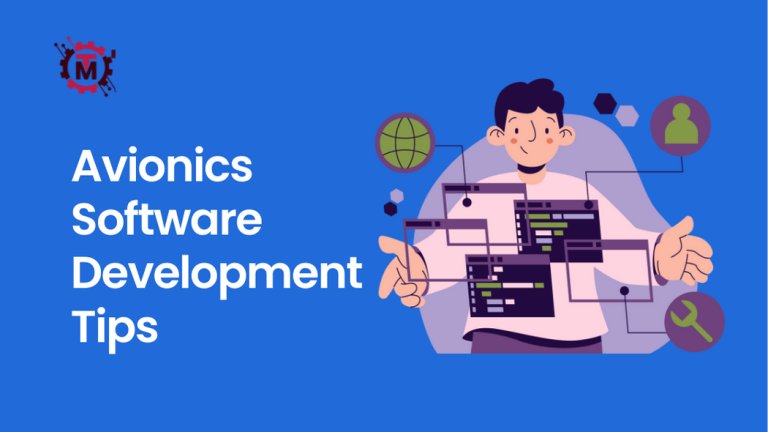Avionics software development plays a crucial role in the aviation industry, enabling the smooth operation and advanced functionality of modern aircraft. Engineers and managers involved in avionics software development face very unique challenges and responsibilities.
This blog post will provide valuable tips and insights for engineers and managers in the field of avionics software development. From best practices to effective strategies, this comprehensive guide will equip professionals with the knowledge and expertise needed to excel in their roles and also achieve mandatory certification which is required for commercial and now military avionics software.
Key Components of Avionics Software
Avionics software consists of several key components that are essential for the proper functioning of aircraft systems. These components include:
Flight Management Systems (FMS)
Flight Management Systems (FMS) are a crucial part of avionics software. They integrate various aircraft systems, including navigation, performance management, and autopilot, to optimize flight operations. FMS enables pilots to enter flight plans, calculate fuel consumption, manage waypoints, and monitor the aircraft’s progress throughout the journey.
Navigation Systems
Navigation systems in avionics software provide accurate positioning and guidance to the pilots. They utilize GPS (Global Positioning System) and other sensors to determine the aircraft’s location and altitude. Navigation systems play a vital role in ensuring safe and efficient flight operations, enabling pilots to follow predetermined routes and avoid potential hazards.
Communication Systems
Avionics software also includes sophisticated communication systems that enable pilots to stay connected with air traffic control, other aircraft, and ground stations. These systems ensure seamless and reliable communication, facilitating the exchange of critical information during flight.
Surveillance Systems
Surveillance systems in avionics software help monitor the aircraft’s surroundings and detect potential obstacles or threats. These systems include radar, transponders, and collision avoidance systems, enhancing situational awareness and contributing to overall flight safety.

Avionics Software Development- Tips for Engineers and Managers
Avionics Software Development is a complex and dynamic field that requires meticulous attention to detail, adherence to safety standards, and continuous innovation. Here are some essential tips for engineers and managers engaged in avionics software development:
1. Stay Updated with Industry Standards and Regulations
Avionics software development operates within a highly regulated environment. Engineers and managers must stay up to date with the latest industry standards, such as DO-178C, which defines software considerations for airborne systems and equipment certification. Compliance with these standards is crucial to ensure safety and reliability in avionics software development.
2. Foster Effective Communication and Collaboration
Successful avionics software development heavily relies on effective communication and collaboration among team members, with the evidence required per the avionics software standard DO-178C cited above. Engineers and managers should establish open lines of communication, encourage regular feedback, promote a collaborative work environment, and retain evidence of all communications and reviews. This approach facilitates the sharing of ideas, addresses challenges promptly, and ensures smooth project execution and certification.
3. Embrace Agile Methodologies
Agile methodologies, such as Scrum or Kanban, have gained significant traction in software development, including avionics. Embracing these methodologies allows for increased flexibility, adaptability, and faster response to changes in requirements. By adopting an iterative and incremental approach, engineers and managers can enhance productivity and deliver high-quality avionics software. It should be noted that DO-178C may seem counter to Agile development to the new practitioner, however safety-critical Agile has been proven repeatedly in aviation by adding evidence, traceability, and formal transition criteria during development.
4. Prioritize Safety and Reliability
Safety and reliability are paramount in avionics software development. Engineers and managers must prioritize rigorous testing, verification, and validation processes to identify and rectify potential issues before deployment. Implementing robust quality assurance measures ensures that avionics software functions flawlessly, contributing to the overall safety of the aircraft while meeting up to 71 DO-178C objectives.
5. Invest in Continuous Training and Skill Development
The field of avionics software development is constantly evolving, driven by advancements in technology and changing industry requirements. Engineers and managers should invest in continuous training and skill development programs to stay updated with emerging trends, tools, and techniques. By nurturing a culture of learning, professionals can enhance their expertise and contribute to the growth and innovation of avionics software development.
6. Implement Effective Change Management
Change is inevitable in avionics software development. Engineers and managers must be adept at managing change effectively. By establishing well-defined change management processes, professionals can mitigate risks associated with software modifications, maintain traceability, and ensure proper documentation. Proactive change management contributes to seamless software upgrades and enhancements.
7. Foster a Culture of Quality
A culture of quality is vital in avionics software development. Engineers and managers should encourage a mindset that prioritizes quality at every stage of the development lifecycle. By adhering to best practices, leveraging automated testing tools, and promoting a culture of accountability, professionals can consistently deliver high-quality avionics software that meets stringent industry standards.
Ending Note
Avionics software development presents unique challenges and demands the expertise of both engineers and managers. By following the tips provided in this guide, professionals in this field can ensure the successful development and implementation of avionics software. Engineers should prioritize thorough requirements analysis, rigorous testing, and adherence to industry standards. Furthermore, effective collaboration with managers throughout the development process is essential for resource allocation, project planning, and risk management. Managers, on the other hand, must adopt a supportive work environment, encourage open communication, and provide necessary resources for the team. Successful integration of these strategies, avionics software development teams can achieve optimal safety, reliability, and efficiency, ultimately contributing to the advancement of the aerospace industry as a whole.


